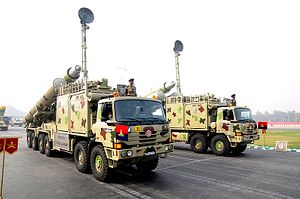The Indian Ministry of Defense’s (MoD) research arm, the Defense Research Development Organization (DRDO), and the Indian Army have test fired a supersonic BrahMos cruise missile at the Integrated Test Range in Chandipur along the coast of Odisha on May 21, according to MoD statement.
The test firing, which took place at 10:40 a.m. local time, reportedly validated new indigenously designed and developed technologies for some of the missile’s subsystems to extend the BrahMos’ service life from ten to 15 years.
“The life extension test firing of BrahMos was conducted from a Static Inclined Launcher, proving the efficacy and longevity of the system which was witnessed by the Scientist [sic] from Defense Research and Development Organization (DRDO) and BrahMos,” a MoD statement read. “The precision strike missile flew in its designated trajectory and the key components functioned perfectly.”
The MoD did not specify what components of the missile were upgraded. “The successful test will result in huge savings of replacement cost of missiles held in the inventory of Indian Armed Forces,” the Indian Minister of Defense, Nirmala Sitharaman, tweeted on May 21 in response to the successful test.
The last test firing of a BrahMos surface-to-surface (Block III) cruise missile took place in March at the Pokhran test range in Rajasthan. It was the first time a ground-launched BrahMos equipped with an indigenous seeker — developed by BrahMos Aerospace and DRDO, and manufactured by state-owned Electronics Corporation of India — was successfully tested.
The BrahMos missile program is a joint venture between India’s DRDO and Russian rocket design bureau NPO Mashinostroyeniya with the former supplying the missile’s inertial navigation system and fire control system, and the latter providing the ramjet propulsion system and seeker technology. Over the last years, India has made a concerted effort to indigenize the Russian-supplied technology of the missile.
The missile itself is a derivative of the Russian P-800 Oniks over-the-horizon supersonic anti-ship cruise missile. Given its maximum speed of Mach 2.8 to 3, the BrahMos is thought to be the one of the world’s fastest cruise missiles currently in operational use. The missile’s maximum operational range is estimated at around 300 to 400 kilometers.
The land-launched and sea-launched variants of the missile are already in service with the Indian Army and Navy.
The Indian Army is in the process of standing up three BrahMos regiments with two regiments reportedly fully operational as of 2018. The anti-ship variant of the missile has been declared fully operational following the successful test firing of the weapon system from the INS Kolkata in June 2014 and February 2015, as well as from the INS Kochi on September 30, 2015. The Indian Navy also for the first time tested a land-attack variant of the supersonic BrahMos in 2017.
The air-launched variant is expected to become operational by the end of 2018 with the Indian Air Force (IAF). The service is also expected to test fire an extended-range air-launched variant of the BrahMos, designated BrahMos-ER, from a Sukhoi Su-30 MKI multirole air superiority fighter jet in the coming month.
In March 2017, DRDO for the first time test fired a BrahMos-ER missile, which is purportedly capable of hitting targets at a distance of up to 800 kilometers.
































